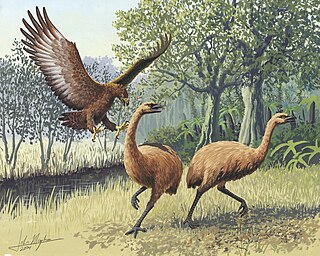 W
WLate Quaternary prehistoric birds are avian taxa that became extinct during the Late Quaternary – the Holocene or Late Pleistocene – and before recorded history, or more precisely, before they could be studied alive by ornithological science. They became extinct before the period of global scientific exploration that started in the late 15th century. In other words, this list basically deals with extinctions between 40,000 BC and 1500 AD. For the purposes of this article, a "bird" is any member of the clade Neornithes, that is, any descendant of the most recent common ancestor of all currently living birds.
 W
WThe adzebills, genus Aptornis, were two closely related bird species, the North Island adzebill, Aptornis otidiformis, and the South Island adzebill, Aptornis defossor, of the extinct family Aptornithidae. The family was endemic to New Zealand. A fossil species, Aptornis proasciarostratus, is known from the Miocene Saint Bathans Fauna.
 W
WCouas are large, mostly terrestrial birds of the cuckoo family, endemic to the island of Madagascar.
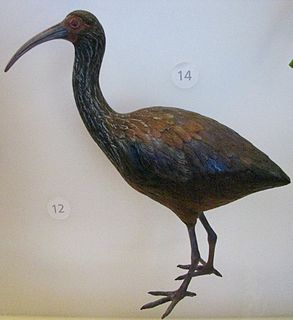 W
WApteribis is an extinct genus of flightless birds in the ibis subfamily that was endemic to the Hawaiian Islands in the Pacific Ocean.
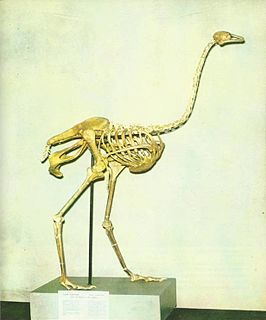 W
WThe Asian or Asiatic ostrich, is an extinct species of ostrich that ranged from Morocco, the Middle East to China and Mongolia. Fossils date from the upper Pliocene to the early Holocene. Beads made from shells taken from archaeological sites in India dating to more than 25000 years were found to have traces of DNA and analysis of sequences examined from them show that the species is definitely in the genus Struthio.
 W
WThe Bahaman caracara, also known as Creighton's caracara, is an extinct bird of prey. It is known only from a few fossils discovered in the Bahamas and Cuba. Caracara creightoni was a scavenger and opportunistic species instead of a predator like its sister extant species. It lived during the late Pleistocene to the beginning of the Holocene era.
 W
WCouas are large, mostly terrestrial birds of the cuckoo family, endemic to the island of Madagascar.
 W
WAnomalopteryx is an extinct bird genus known colloquially as the lesser moa, little bush moa, or bush moa. It stood more than 1.3 metres (4.3 ft) tall and weighed 30 kilograms (66 lb). It inhabited much of the North Island and small sections of the South Island of New Zealand. Its habitat was lowland conifer, broad-leafed, and Southern beech forests. It is monotypic with the only species discovered is Anomalopteryx didiformis. It is also the smallest known species of moa, weighing barely 30 kg and standing less than a metre tall.
 W
WThe Canary Islands quail once occurred on the islands of El Hierro, La Palma, Tenerife and Fuerteventura.
 W
WThe Chatham raven is a prehistoric raven formerly native to the Chatham Islands. The closely related New Zealand raven, C. antipodum occurred in the North and South Islands of New Zealand. C. antipodum was formerly included in C. moriorum, and later considered a distinct species, however in 2017 genetic research determined that the two raven populations were subspecies rather than separate species, having only split 130,000 years ago.
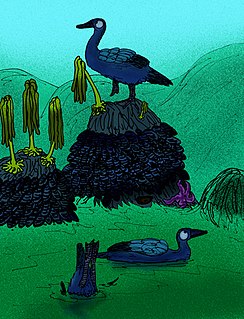 W
WChendytes lawi was a goose-sized flightless seaduck, once common on the California coast, the California Channel Islands, and possibly southern Oregon. It lived in the Pleistocene and survived into the Holocene. It appears to have gone extinct at about 450–250 BCE. IThe youngest direct radiocarbon date from a Chendytes bone fragment dates to 770–400 BCE and was found in an archeological site in Ventura County. Its remains have been found in fossil deposits and in early coastal archeological sites. Archeological data from coastal California show a record of human exploitation of Chendytes lawi for at least 8,000 years. It was probably driven to extinction by hunting, animal predation, and loss of habitat. Chendytes bones have been identified in archaeological assemblages from 14 coastal sites, including two on San Miguel Island and 12 in mainland localities. Hundreds of Chendytes bones and egg shells found in Pleistocene deposits on San Miguel Island have been interpreted as evidence that some of these island fossil localities were nesting colonies, one of which Guthrie dated to �12,000 14C years. There is nothing in the North American archaeological record indicating a span of exploitation for any megafaunal genus remotely as long as that of Chendytes.
 W
WThe conquered lorikeet is a species of parrot that became extinct 700–1300 years ago. It lived in islands of Polynesia. David Steadman and Marie Zarriello wrote its species description in 1987.
 W
WThe Saint Helena dove was a species of flightless bird in the family Columbidae. It is monotypic within the genus Dysmoropelia. It was endemic to the island of Saint Helena in the South Atlantic Ocean. It is known from remains of Late Pleistocene age found at the Sugarloaf Hill locality, which consists of aeolian calcareous sands. The holotype consists of a right coracoid, with paratypes consisting of "distal end of right tarsometatarsus, (S/1963.25.29) distal half of right humerus, (S/1963.25.26) worn left tibiotarsus lacking distal end, distal portion of shaft of left tarsometatarsus, (S/1963.25.30) worn proximal end of right humerus. left ulna, proximal fragments of left ulnae, (175959) proximal end of right femur, (175962) distal end of right humerus"
 W
WDow's puffin is an extinct seabird in the auk family described in 2000 from subfossil remains found in the Channel Islands of California.
 W
WThe dune shearwater, also known as the Canarian shearwater or Hole's shearwater, was a relatively large shearwater which bred in the Canary Islands archipelago of the North Atlantic Ocean. Fossils have also been found in the Figueira Brava cave archaeological site on the western coast of Portugal. The specific epithet honours Mrs Jean Hole who collected fossil material of the species on the Jandia Peninsula of Fuerteventura. It was intermediate in size between the Manx and Cory's shearwaters. Its breeding colonies were in dune fields, in contrast to those of the smaller and sympatric lava shearwater which bred in lava fields. Extinction of the species occurred about 2000–3000 years ago, contemporaneously with the first human settlement of the islands by the Guanches, with the cause likely to be human predation.
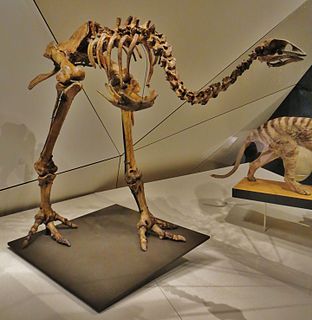 W
WThe eastern moa, Emeus crassus, is an extinct species of moa. When the first specimens were originally described by Richard Owen, they were placed within the genus Dinornis as three different species, but, was later split off into their own genus, Emeus. E. crassus is currently the only species of Emeus, as the other two species, E. casuarinus and E. huttonii are now regarded as synonyms of E. crassus. It has been long suspected that the "species" described as Emeus huttonii and E. crassus were males and females, respectively, of a single species. This has been confirmed by analysis for sex-specific genetic markers of DNA extracted from bone material; the females of E. crassus were 15-25% larger than males. This phenomenon — reverse size dimorphism — is not uncommon amongst ratites, being also very pronounced in kiwis.
 W
WEudyptes warhami, the Chatham penguin or Warham penguin, was a species of crested penguin, now extinct, endemic to the Chatham Islands east of mainland New Zealand. It is known only from subfossil bones, and probably became extinct shortly after Polynesians arrived in the Chathams about 450 years ago.
 W
WThe great Maui rail or great Maui crake is an extinct bird species from Maui, one of two flightless rails which survived on Maui until people arrived in 150 C.E.
 W
WThe greater Azores bullfinch was a large, extinct species of bullfinch in the family Fringillidae that was once endemic to the Azores. It is the first known extinct passerine to be described from the islands. It is the largest known member of its genus based on its skull size, and had a very robust beak reminiscent of that of a parrot. However, the remains are otherwise reminiscent of the extant but highly endangered Azores bullfinch.
 W
WThe Haast's eagle is an extinct species of eagle that once lived in the South Island of New Zealand, commonly accepted to be the pouakai of Maori legend. The species was the largest eagle known to have existed, with an estimated weight of 15 kilograms (33 lb) nearly double that of the Harpy eagle at 9 kilograms (20 lb). Its massive size is explained as an evolutionary response to the size of its prey, the flightless moa, the largest of which could weigh 230 kg (510 lb). Haast's eagle became extinct around 1400, after the moa were hunted to extinction by the first Māori.
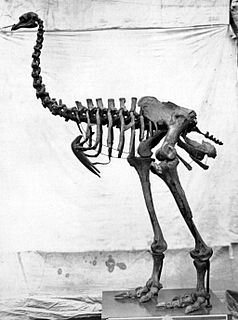 W
WThe heavy-footed moa is a species of moa from the family Dinornithidae. This moa was widespread only in the South Island of New Zealand, and its habitat was the lowlands. It was a ratite and a member of the order Struthioniformes. The Struthioniformes are flightless birds with a sternum without a keel. They also have a distinctive palate. The origin of these birds is becoming clearer as it is now believed that early ancestors of these birds were able to fly and flew to the southern areas in which they have been found.
 W
WThe high-billed crow or deep-billed crow was a species of large, raven-sized crow that was endemic to the island of Maui in the Hawaiian Islands. It was pushed to extinction due to the arrival of people and pests like rats.
 W
WThe lava shearwater, or Olson's shearwater, was a species of shearwater that bred on Lanzarote and Fuerteventura in the Canary Islands. It is known from fossil remains, and was only described in 1990. It was intermediate in size between the Manx shearwater and the little shearwater. The remains of the species are particularly common in lava fields.
 W
WThe long-legged bunting is an extinct flightless species of bunting. It was distinguishable by its long legs and short wings, and it inhabited Tenerife, one of the Canary Islands. It is one of the few flightless passerines known to science, all of which are now extinct.
 W
WThe St. Croix macaw or Puerto Rican macaw, is an extinct species of macaw whose remains have been found on the Caribbean islands of St. Croix and Puerto Rico. It was described in 1937 based on a tibiotarsus leg bone unearthed from a kitchen midden at a pre-Columbian site on St. Croix. A second specimen consisting of various bones from a similar site on Puerto Rico was described in 2008, while a coracoid from Montserrat may belong to this or another extinct species of macaw. The St. Croix macaw is one of 13 extinct macaw species that have been proposed to have lived on the Caribbean islands. Macaws were frequently transported long distances by humans in prehistoric and historical times, so it is impossible to know whether species known only from bones or accounts were native or imported.
 W
WMantell's moa also known as Mappin's moa is an extinct species of New Zealand birds of the family Moa. These moa were endemic to the North Island. They were abundant in low lying. Its habitat was the lowlands. It was a ratite and a member of the Struthioniform Order. The Struthioniformes are flightless birds, whose sternum lacks a keel and whose palate is distinctive. The origin of the Mantell's Moa is becoming clearer as it is now believed that early ancestors of these birds were able to fly and flew to the southern areas where their remains have been recovered.
 W
WThe Mauritius starling is an extinct species of starling, described in 2014 by Julian P. Hume, based on subfossils from Mauritius. The holotype mandible was discovered in 1904, but was hidden in a museum drawer for over a hundred years, hence the genus name. The Mauritius starling was shown to be closer to the Rodrigues starling than to the hoopoe starling of Réunion.
 W
WMoa were nine species of now-extinct flightless birds endemic to New Zealand. The two largest species, Dinornis robustus and Dinornis novaezelandiae, reached about 3.6 m (12 ft) in height with neck outstretched, and weighed about 230 kg (510 lb) while the smallest, the bush moa, was around the size of a turkey. Estimates of the Moa population when Polynesians settled New Zealand circa 1300, vary between 58,000 to c. 2.5 million.
 W
WThe moa-nalo are a group of extinct aberrant, goose-like ducks that lived on the larger Hawaiian Islands, except Hawaiʻi itself, in the Pacific. They were the major herbivores on most of these islands until they became extinct after human settlement.
 W
WThe Maui Nui large-billed moa-nalo, also known as the Maui Nui moa-nalo, is one of two species of moa-nalo in the genus Thambetochen. Moa-nalo are a group of extinct, flightless, large goose-like ducks, which evolved in the Hawaiian Islands of the North Pacific Ocean.
 W
WThe Oʻahu moa-nalo is one of two species of moa-nalo in the genus Thambetochen. Moa-nalo are a group of extinct, flightless, large goose-like ducks, which evolved in the Hawaiian Islands of the North Pacific Ocean.
 W
WThe small-billed moa-nalo, also known as the stumbling moa-nalo, is a species of moa-nalo, one of a group of extinct, flightless, large goose-like ducks, which evolved in the Hawaiian Islands of the North Pacific Ocean. It was described in 1991 from subfossil material collected in September 1982 by Storrs Olson, Helen James and others, from the Auwahi Cave on the southern slopes of Haleakalā, on the island of Maui.
 W
WThe turtle-jawed moa-nalo, also formerly referred to as the large Kauai goose, is a species of moa-nalo, one of a group of extinct, flightless, large goose-like ducks, which evolved in the Hawaiian Islands of the North Pacific Ocean. It was described in 1991 from subfossil material collected in 1976 by Storrs Olson from the calcareous Makawehi dunes on the south-eastern coast of the island of Kauai. Its remains have also been found at the nearby Makauwahi Cave site.
 W
WThe broad-billed, stout-legged moa or coastal moa is an extinct species of moa. These moa lived in both the North and the South Islands of New Zealand, and on Stewart Island. Its habitat was in the lowlands. It was a ratite and a member of the Struthioniformes Order. The Struthioniformes are flightless birds with a sternum without a keel. They also have a distinctive palate. The origin of these birds is becoming clearer as it is now believed that early ancestors of these birds were able to fly and flew to the southern areas that they have been found in.
 W
WThe North Island giant moa is one of two extinct moa in the genus Dinornis.
 W
WThe South Island giant moa is a member of the moa family. It was a ratite and a member of the order Dinornithiformes. The Dinornithiformes are flightless birds with a sternum without a keel. They also have a distinctive palate. The origin of these birds is becoming clearer as it is now believed that early ancestors of these birds were able to fly and flew to the southern areas in which they have been found.
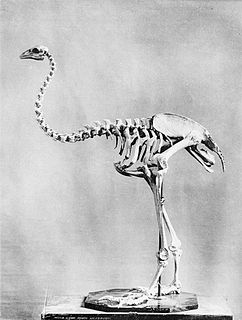 W
WThe upland moa was a species of moa bird endemic to New Zealand. It was a member of the ratite family, a type of flightless bird with no keel on the sternum. It was the last moa species to become extinct, vanishing around 1500 CE and was predominantly found in alpine and sub-alpine environments.
 W
WThe New Zealand goose is the common name given to the extinct genus Cnemiornis of the family Anatidae, subfamily Anserinae.
 W
WThe Cuban giant owl or giant cursorial owl (Ornimegalonyx) is an extinct genus of giant owl that measured 1.1 metres in height. It is closely related to the many species of living owls of the genus Strix. It was a flightless or nearly flightless bird and it is believed to be the largest owl that ever existed. It lived on the island of Cuba.
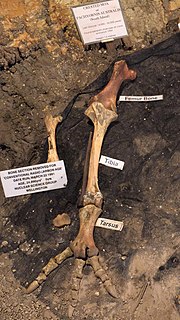 W
WThe crested moa, Pachyornis australis, were a species of moa from the family Dinornithidae. It is one of the 9 known species of moa to have existed. Moa are grouped together with emus, ostriches, kiwi, cassowaries, rheas, and tinamous in the clade Palaeognathae. Some of the species of this group are flightless and lacks a keel on their sternum. The name crested moa is due to pits being found in their skulls, suggesting they had crests of long feathers. These cranial pits are also found occasionally in Dinornis, Anomalopteryx, and other Pachyornis species.
 W
WPachyplichas is a genus containing two extinct species of New Zealand wren, a family of small birds endemic to New Zealand.
 W
WThe oceanic eclectus parrot is an extinct parrot species which occurred on Tonga, Vanuatu and possibly on Fiji. Its only living relative is the eclectus parrot, which has proportionally larger wings than the oceanic eclectus parrot. The fossil material unearthed in November 1989 in Late Pleistocene and Holocene deposits on 'Eua, Lifuka, 'Uiha and Vanuatu and described in 2006 by David William Steadman include a complete femur, five radii, a quadrate bone, a mandible, a coracoid, two sterna, two humeri, two ulnae, two tibiotarsi, a carpometacarpus, a tarsometatarsus, and three pedal phalanges.
 W
WThe Puerto Rican quail-dove is an extinct species of dove from the genus of quail-doves Geotrygon. It is only known by subfossil material from the Holocene.
 W
WThe ʻEua rail is an extinct species of flightless bird in the Rallidae, or rail family. It was described in 2005 from subfossil bones found on the island of ʻEua, in the Kingdom of Tonga of West Polynesia.
 W
WThe slender-billed greenfinch (Chloris aurelioi) is an extinct songbird in the finch family Fringillidae. It was found in the island Tenerife of the Canary Islands. It was described on September 23, 2010. It occurred during the Holocene epoch.
 W
WThe South Island stout-legged wren or Yaldwyn's wren is an extinct species of New Zealand wren, a family of small birds endemic to New Zealand.
 W
WMarquesas swamphen is a presumably extinct species of swamphen from the Marquesas Islands Hiva Oa and Tahuata. It was originally described from 600-year-old subfossil remains from Tahuata and Hiva Oa. It may have survived to around 1900; in the lower right corner of Paul Gauguin's 1902 painting Le Sorcier d'Hiva Oa ou le Marquisien à la cape rouge there is a bird which resembles native descriptions of Porphyrio paepae. Thor Heyerdahl claimed to have seen a similar flightless bird on Hiva Oa in 1937.
 W
WSylviornis is an extinct genus of stem-galliform bird containing a single species, S. neocaledoniae, or erroneously, "New Caledonian giant megapode". Technically, the latter is incorrect because it has recently been found not to be a megapode, but one of two genera in the family Sylviornithidae; at the time of its description, it was believed to be a ratite. Sylviornis was never encountered alive by scientists, but it is known from many thousands of subfossil bones found in deposits, some of them from the Holocene, on New Caledonia and the adjacent Île des Pins. Recent morphological studies indicate that it was a sister taxon of Megavitiornis, in a clade outside of the Galliformes crown group.
 W
WSylviornithidae is an extinct family of flightless birds. Traditionally assumed to be within Galliformes, recent phylogenetic studies showcase that they rest outside of the galliform crown-group, making them the most recently lived non-galliform Pangalliformes. For many years it was considered a monotypic family consisting of Sylviornis alone, but recent studies show that Megavitiornis was part of this clade as well.
 W
WThe North Island takahē or mōho is an extinct rail that was found in the North Island of New Zealand. This flightless species is known from subfossils from a number of archeological sites and from one possible 1894 record. It appeared to have been even larger than the South Island takahē and, if it did survive until the 1890s, would have been the largest rail in historic times. The decline of the species has generally been attributed to the increasing incursion of forest into the alpine grasslands through the Holocene, although hunting by the Māori also played a major role.
 W
WTeratornis was a genus of huge North American birds of prey – the best-known of the teratorns - of which, two species are known to have existed: Teratornis merriami and Teratornis woodburnensis. A large number of fossil and subfossil bones, representing more than 100 individuals, have been found in locations in California, Oregon, southern Nevada, Arizona, and Florida, though most are from the Californian La Brea Tar Pits. All remains except one Early Pleistocene partial skeleton from the Leisey Shell Pit near Charlotte Harbor, Florida date from the Late Pleistocene, with the youngest remains dating from the Pleistocene-Holocene boundary.
 W
WThambetochen is an extinct genus of moa-nalo duck. It contains two species, the Maui Nui moa-nalo and the smaller O'ahu moa-nalo.
 W
WTongoenas also known as the Tongan giant pigeon is an extinct genus of giant pigeon that grew up to 51 centimetres (20 in) long that was once native to the islands of Tonga. It has existed for at least 60,000 years, and went extinct around 850-600 BC. The type species and only known species, T. burleyi, was named in 2020 based on subfossil remains.
 W
WThe Trias greenfinch is an extinct passerine from the family of finches (Fringillidae). The fossil remains were unearthed in the Cuevas de los Murciélagos near San Andrés y Sauces in the north of La Palma, Canary Islands. The species epithet commemorates Spanish palaeontologist Miquel Trías who collected the holotype together with Josep Antoni Alcover in July 1985.
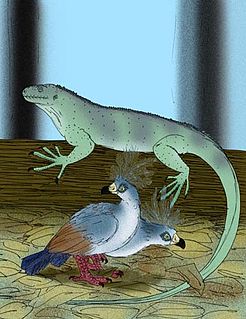 W
WThe Viti Levu giant pigeon or Fiji giant ground pigeon is an extinct flightless pigeon of Viti Levu, the largest island in Fiji. It was only slightly smaller than the dodo and Rodrigues solitaire and is the first giant, flightless pigeon to be discovered on a Pacific island.